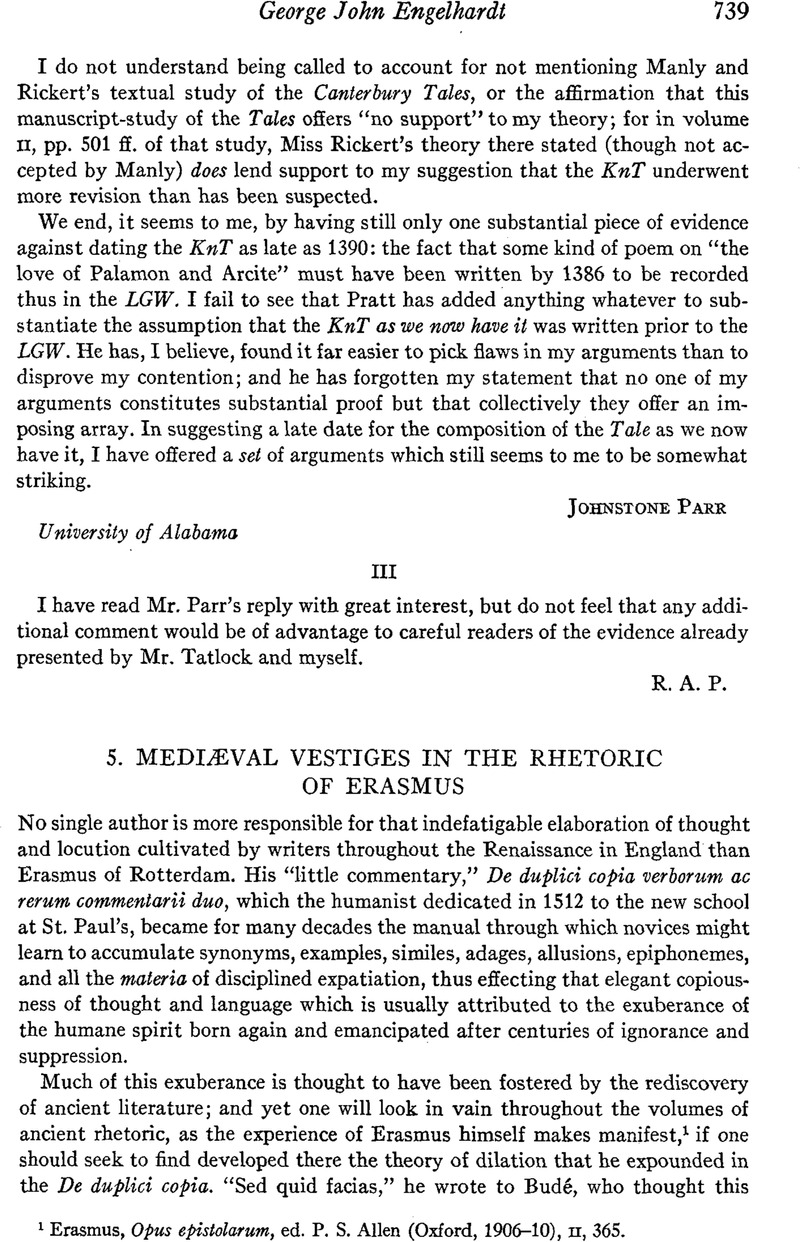Published online by Cambridge University Press: 02 December 2020

1 Erasmus, Opus epistolarum, ed. P. S. Allen (Oxford, 1906-10), ii, 365.
2 Ibid., p. 232.
3 Ibid., p. 365.
4 Ibid., pp. 232, 254-5, 274.
5 Cf. T. M. Charland, Artes praedicandi: contribution l'histoire de la rh torique au moyen áge (Paris Ottawa, 1936), p. 211.
6 I.e., “sunt autem quatuor modi exponendi: litteralis, allegoricus, tropologicus vel moralis, anagogicus.” The immediate source of my terminology for the homiletic modes is the Third Part of an ars concionandi falsely attributed to St. Bonaventure and published in the Quaracchi (1901) edition of his works; see ibid., rx, 17-21. This Third Part derives from the famous ars concionandi of the thirteenth-century English monk, Richard of Thet-ford. “Un des trait s les plus r pandus est celui qui porte sur les huit modes de d velopper un sermon. Il a t pill et abr g de toutes mani res, par le Pseudo-Bonaventure (3e partie), par Martin d'Amberg, par Olivier de Went, par Robert de Basevorn et Ranulphe Higden, et par plusieurs anonymes. Il se rencontre sous le nom de son v ritable auteur, Richard de Thetford, parfois sous celui d'Albert le Grand.” Charland, op. cit., p. 77.
7 The eighth mode may also embrace the locus ex adjunctis. The designations of the loci are from Boethius, In Topica Ciceronis commentariorum libri sex.
8 Cf. Aristotle, Prior Analytics, ii, xxiii-xxvii.
9 Cf. E. Faral, Les arts po tiques du XIIe et du XIIIe si cle (Paris, 1924), p. 62.
10 Ibid., pp. 63 ff.
11 See Faral, pp. 63-4.
12 Rhetores Latini minores, ed. K. Halm (Leipzig, 1863), pp. 551-2.
13 Opus epistolarum, i, 117.
14 Ibid., p. 124.
15 Cf. Faral, p. 38.
16 Epistolae obscurorum virorum, ed. F. G. Stokes (New Haven London, 1925), p. 98.
17 Faral, p. 204.
18 Ars versificatoria, ed. Faral, op. cit., pp. 118-51.
19 “Est enim circumlocutio quando sententiam aliquam dicturi eam non directe dicimus, sed quasi in circuitu ambulamus et per quasdam circumstantias sub ampliori s rie verborum ipsam insinuamus.” Documentum de modo et arte dictandi et versificandi, ed. Faral, op. cit., p. 273; cf. Poetria nom, vv. 230-1, ed. Faral, op. cit., p. 204.
20 Erasmus, Opera omnia, ed. J. LeClerc (Leyden, 1703), i, 83E.
21 Cf. Faral, p. 61.
22 Macrobius, Saturnalia, v.i.7; Erasmus, Opera omnia, i, 4C.
23 Quintilian, Institutio oratorio, x.i.61; Erasmus, ibid., p. 5F.
24 Cicero, De oratore, ii .142; De inventione, ii.50; Pro M. Caelio oratio, 45; Seneca rhetor, Controversiae, iv.praef.7.
25 Ciceronis orationum scholiastae, ed. T. Stangl (Vienna Leipzig, 1912), ii, 332.
26 Les fabulistes latins, ed. L. Hervieux (Paris, 1894), iii, 463-4.